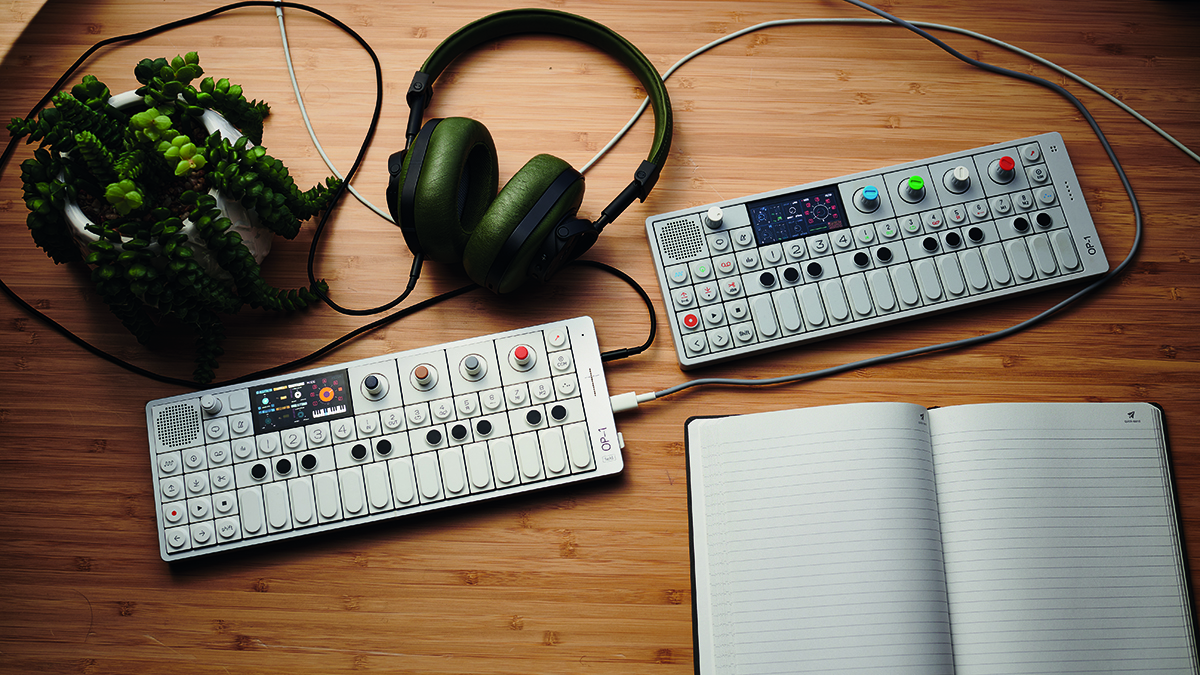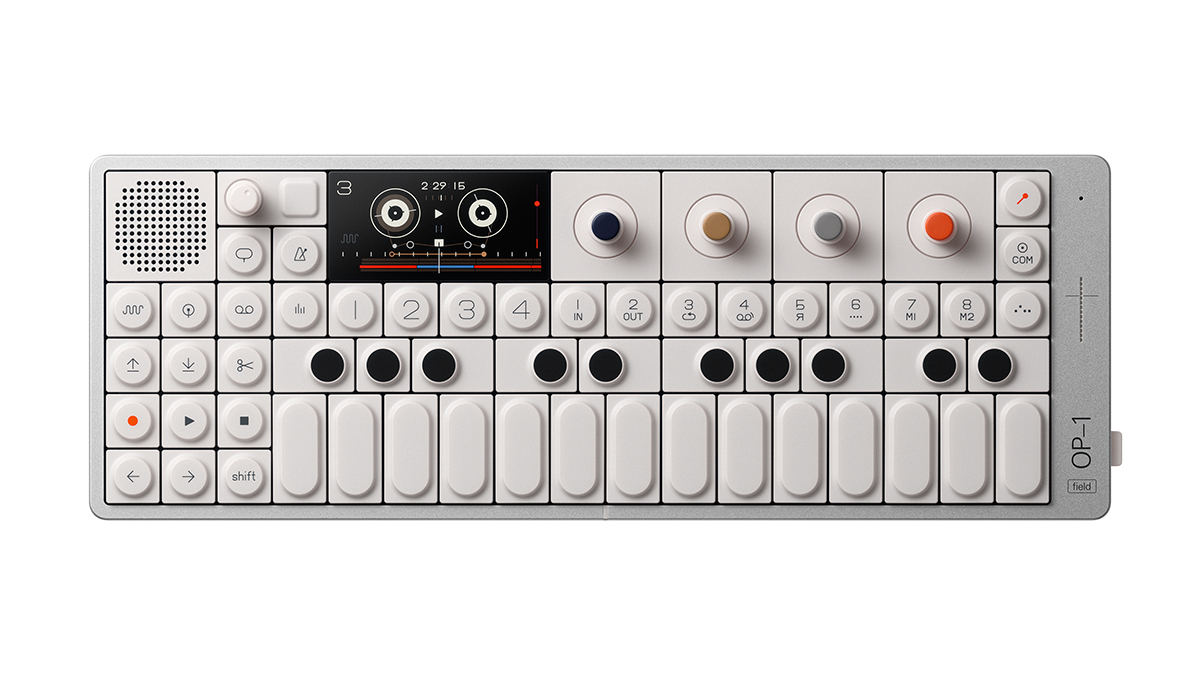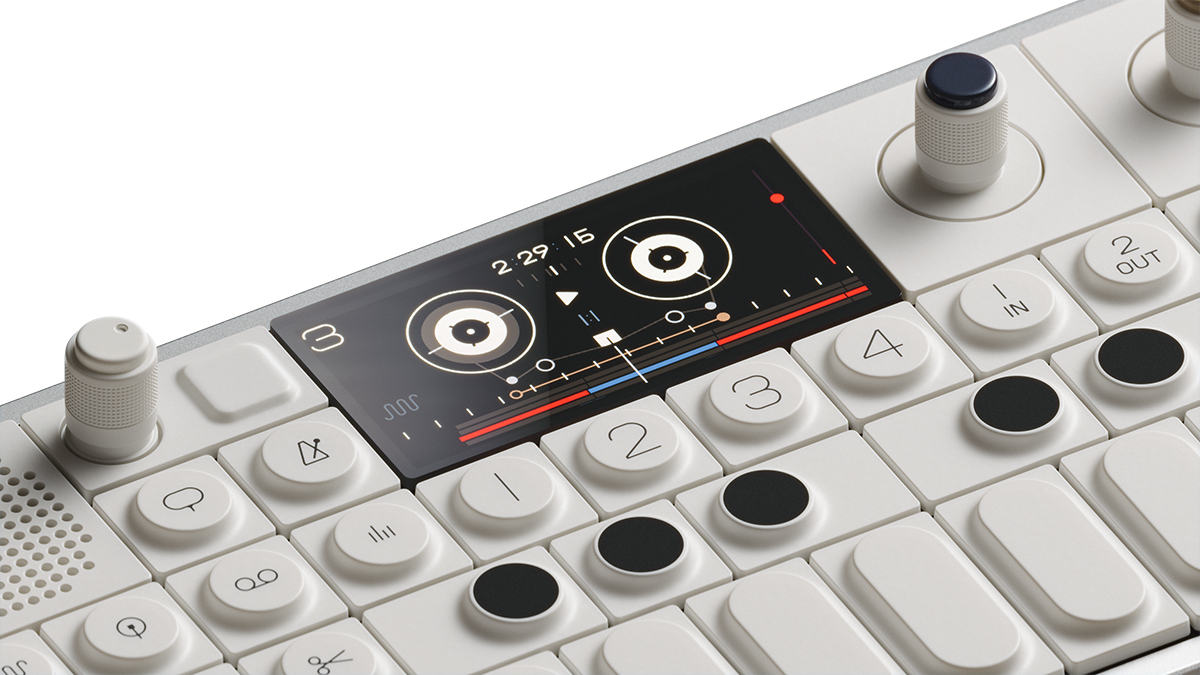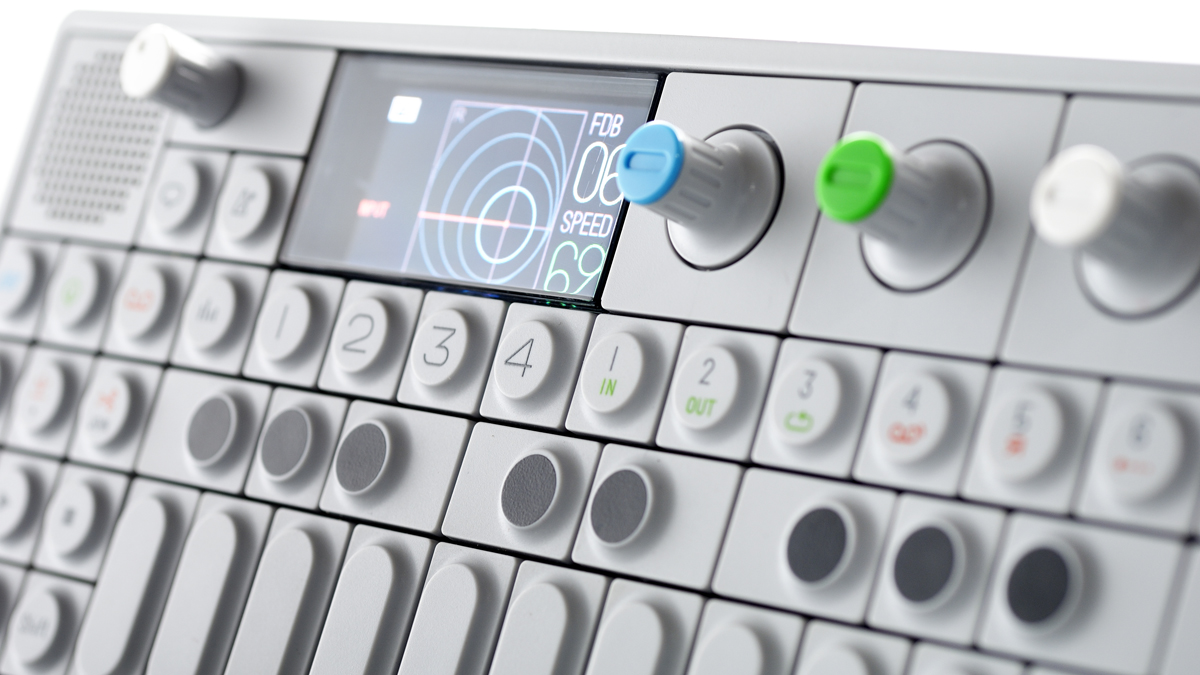Teenage Engineering OP-1 vs OP-1 Field: which is the best portable synth?
We put the iconic hipster-friendly electronic instruments head to head

Teenage Engineering’s OP-1 is one of the most desirable pieces of music production gear of the past decade.
With a huge number of features, including several synthesizer engines, sampling options, creative modulation, a drum machine, effects, six sequencers, digital multitrack ‘tape’ recording, MIDI control and even a radio, all behind TE’s ultra cool operating system (both quirky and very easy - a rare combo), OP-1 has become an accessory that no East London vinyl and Eurorack collector dare be without.
In fact, when TE temporarily stopped making the OP-1 in late 2018, it became so essential that secondhand prices soared into four figures, well beyond its initial retail price.
Teenage Engineering then did exactly what you might expect, given the demand. It reintroduced OP-1 in 2019 with a higher price of $1299/£1199/€1399. And while that caused some consternation, demand for the OP-1 did not wane.
A couple of years on, though, and perhaps realising the technology was well over a decade old, Teenage Engineering went back to the OP-1 drawing board, and at this year’s Superbooth, announced OP-1 Field.
This is a much pimped-up OP-1 - not a replacement, more a flashier and more expensive older sibling that TE describes as ‘a continuation’ of the OP-1 line. It has one hundred more features, an even more eye-watering price tag and has caused enough of a buzz to finally knock secondhand prices of the original OP-1 into a much more sensible territory.
But can OP-1 Field really be worth $£1999? Should you consider a new original OP-1 at $£600 less. Or, should you even consider the original at its now much more reasonable secondhand price? Let’s line up the old and new OP-1s to get some answers…
Get the MusicRadar Newsletter
Want all the hottest music and gear news, reviews, deals, features and more, direct to your inbox? Sign up here.
Teenage Engineering OP-1 vs OP-1 Field: At a glance
OP-1
- Price: $1,399/£1,399
- Screen: Amoled display running @ 60 fps, 320 x 160 pixel resolution
- Battery life: 16 hours
- Processing: 400 MHz processor, 64MB memory, 24-bit 96kHz operation, stereo out only
- Number of presets: Around 170
- Polyphony: 6 voices
- Number of engines: 13 including Drum Sampler, Synth Sampler and D-Box drum synth
- Number of drum kits: 14 sampled plus 10 D-Box kits
- Number of effects: 7 (Delay, Grid, Nitro, Phone, Punch, Spring, CWO)
- Number of sequencers: 7 (Pattern, Finger: Synth, Finger: Drum, Endless, Tombola, Sketch, Arpeggio)
- Tape machines: 1 with 6 minutes of recording time (in normal tape speed and 44.1kHz/16 bits) and 4 individual tracks, so 24 minutes total
- Drum Sampler: 12 seconds of recording time
- Synth Sampler: 6 seconds of recording time
- Connections: 3.5mm audio in/line in, 3.5mm audio out for headphones/line out, USB Mini B port for charging, streaming audio, file transfers and MIDI
- Dimensions (mm): 282 x 102 x 27
- Weight (kg): 0.58
OP-1 Field
- Price: $1,999/£1,999
- Screen: Hard glass display with a higher definition (not stated) than that of OP-1
- Battery life: 24 hours
- Processing: Processor not stated, 256MB memory, 32-bit 96kHz operation, complete stereo signal path
- Number of presets: Around 200 (up to 500 locations)
- Polyphony: Not stated but appears to be 6 voices
- Number of engines: 14 including new Dimension synth engine, Drum Sampler, Synth Sampler and D-Box drum synth. All engines now in stereo
- Number of drum kits: 15 new sampled kits plus 10 D-Box kits (same as OP-1)
- Number of effects: 8 (Mother, Delay, Grid, Nitro, Phone, Punch, Spring, CWO)
- Number of sequencers: 8 (Click To Hold, Pattern, Finger: Synth, Finger: Drum, Endless, Tombola, Sketch, Arpeggio)
- Tape Machines: 4 (Studio and Vintage reel-to-reel, Porta cassette, Disc Mini) with 160 minutes of recording time in normal tape speed and 44.1kHz/16 bits and 4 individual tracks and up to 8 different tapes
- Sampler: 20 seconds of recording time with dual layer mode for instant A/B channel mixing
- Connections: 3.5mm audio in/line in, 3.5mm audio out for headphones/line out, USB-C port for charging, streaming audio, file transfers and MIDI
- Dimensions (mm): 288 x 102 x 29
- Weight (kg): Not stated, around 0.53
Teenage Engineering OP-1 vs OP-1 Field: Build quality and design
Put side by side you’d be hard-pressed to tell much difference between the two OP-1s at first. Both are gorgeous; the original is still as cool, compact and playable as it was when it was released in 2011. ‘Why change such a good design?’, TE might well have thought, so largely it hasn’t with OP-1 Field.
The units are the same height and similar width with identically sized keys, knobs and - at first glance - speakers. The operating systems are similar, too, with four main sections - synth, drum, tape and mixer.
You get four hotkeys (which change function depending on the section you are in) and four coloured rotaries to control their similarly coloured functions on screen. Field loses the blue, green, white and orange rotaries in favour of dark blue, brown/gold, grey and orange. Consequently the ‘shift’ (secondary) functions on the keys are in correspondingly different colours, although they are mostly in the same place and do the same thing as on the original OP-1.
The screen and speaker tip the balance massively towards Field.
So, what are the differences? OP-1 Field is a tad lighter and not quite as deep as OP-1. It also boasts velcro pads beneath it so you can attach it to your keyboard or laptop. But the first and biggest difference you notice on power up (bar the power button which is more ‘switch’ on OP-1 Field) is the speaker, which on Field comes with a passive radiator and ‘side-shooting loudspeaker grill’. It’s not obviously bigger but is louder than that on the OP-1, and has a much better acoustic design and sound, with the bass frequencies much more noticeable.
Then there’s Field’s screen. We were expecting a touch experience for the best part of two grand, but while you don’t get that, it is a big improvement over the original OP-1 display. The operating systems are almost identical (if you’ve used the original, Field will be second nature to you), but the new screen offers much more detail, plus there’s an adjustable brightness control.
It’s the drum and synth sampling engines that best demonstrate the new display, with the samples shown in greater finery and in stereo, as the whole signal path in Field - from sampling in, through the various synth and sampling engines, to playback - is now in stereo. The screen is hi-res enough to really get up close to your samples - when you’re zooming in and out, or editing attack and fade points on loops - and the screen also shows samples as proper waveforms as opposed to the sparse outlines you get on OP-1.
The screen and speaker tip the balance massively towards Field, then. Plus, the FM antenna on Field is built into its body, which keeps the unit more compact, and the aluminium surround feels very sturdy.
Winner: The OP-1 Field takes the lead here because of the speaker, and the extra screen detail is stunning.
Teenage Engineering OP-1 vs OP-1 Field: Playability

With almost identical designs in terms of their keys, OP-1 Field and OP-1 deliver identical playing experiences when played as musical keyboards; that is, not perfect, but pretty decent.
These aren’t traditional keyboards in any sense - they are more sets of switches without velocity-sensitivity or aftertouch.
That said, you can ‘play’ both units with both hands (just) and it’s not exactly a terrible experience given the small form factors. Indeed, we’ve seen ‘proper’ players playing both OP-1s as you would a proper keyboard. Don’t expect the kind of weighted key experience you’ll get on bigger MIDI keyboards and synths, however, nor the polyphony. The original boasts just eight voices and the new Field’s count is not stated, but we measured just eight in our tests as well.
Both OP-1s can act as MIDI controllers (via USB) with Field able to send MIDI data via Bluetooth, too. But when it comes to the actual playing of the units they are very similar, and Field doesn’t really add anything to the experience here. It’s slightly lighter and thinner, but that neither adds or detracts from the experience, so it’s honours even when it comes to playability.
Winner: OP-1 and OP-Field share the spoils in the playability stakes with both having an identical keyboard feel.
Teenage Engineering OP-1 vs OP-1 Field: Sounds/tone
With an extra synth engine, stereo everywhere, extra sampling features and a largely overhauled beats section, Field is sonically more diverse than the original OP-1, right from the get go.
The new synth engine, Dimension, is a simple but fairly flexible affair. You can choose from a variety of waveforms (noise, saw, square, etc) and then adjust stereo width, filter and resonance with the other three coloured rotaries. It’s decent if not mind-blowing, and you wonder if it could be added to the original OP-1 as a software update.
More exciting and impressive are the synth sampling and drum extras in OP-1 Field. With different sampled kits (the D-Box drum synth kits remain the same) and improved sample zooming, everything looks, feels and sounds that much more professional. It still uses the same cool way of dividing up a break or lengthy sample (the maximum time of which has increased to 20 seconds) into constituent beats, but there’s more accuracy and extra envelope options for transient editing.
The biggest factors that affect the sound and tone, though, are the stereo enhancements and the physical speaker. The stereo effects reveal just how exceptional the stereo sound can now be, with an all-new Mother reverb adding a lot to the rich reverb atmosphere that Field is capable of - it’s pretty stunning.
The quality of the new speaker really reveals itself when you play identical synth presets next to one another from Field and the original OP-1 - the difference is dramatic. With the original we always find ourselves wanting to plug it into bigger speakers to enjoy the fantastic presets and synth options. Not so with Field. Partly thanks to the updated 32-bit operating system, but more to do with the improved speaker and stereo engines, Field delivers a more defined and refined sound that makes the original OP-1 sound thin and raspy in comparison.
Sounds/tone winner: OP-1 Field wins out with bigger beats, more recording options, more stereo, more space and, more importantly than all of those, a better speaker to hear it all through.
Teenage Engineering OP-1 vs OP-1 Field: Hardware and features

The big news is that OP-1 Field has at least 100 extra features. We’ll cover as many of these as we can, although some are way more important than others (we’re not that excited by ‘new font’ and ‘new packaging’, for example).
The speaker, stereo routing and screen are the biggies, while a bolstered internal memory of 256MB helps deliver sample storage of a whopping 160 minutes (24 minutes on OP-1) and around 200 presets (170 on OP-1).
The signal path is full 32-bit stereo throughout, as are all of the synth engines, of which there’s that brand new one, Dimension, as detailed above. All of the original synth engines from OP-1 are here, as are the original presets, albeit now in stereo.
We’ve also touched on the extra beat features, and there’s also a built-in antenna for the FM radio - for both receiving and transmitting (so you can set your own radio station up and broadcast your musical efforts, albeit over a limited range). Perhaps most importantly, you get an extended battery life of 24 hours with Field - that’s 50% more than that quoted for OP-1.
One of the coolest features on the original OP-1 is the ‘tape’ recorder, which is obviously really a multitrack digital recorder but exhibits lots of retro tape-like functions and actually works well as a musical notepad. You can properly use it to quickly record musical ideas and it works great alongside OP-1’s many sequencing options, too. Field adds a Click To Hold Sequencer to these tools, but there’s a lot more added to the tape side of things.
You get four different ‘tape machine’ options: Studio and Vintage 4-track reel-to-reel, Porta 4-track cassette and - this is so Teenage Engineering - a MiniDisc (Disc Mini) option. Of course you do.
Each has its own character, albeit rather subtle and hard to distinguish at first. We didn’t get as much lo-fi as we were expecting with the Porta/cassette option, but the saturation on the Vintage tape is noticeable. You also get eight swappable tapes so you can have multiple projects on the go.
Suffice to say, Field does have a lot more going for it. Teenage Engineering says ‘louder, thinner and 100 times better’. We’d argue with all of that (it’s not massively louder or thinner and the pedant in us obviously wants to point out that ‘100 times better’ is factually incorrect) but overall there are massive improvements. The screen and speaker alone make you feel like you’re getting an instant return on your extra cash outlay, but the extras you’ll discover as you dig deeper into the taping, sampling and stereo mixing will reward you even more.
Features winner: OP-1 Field is way ahead of OP-1 here. It’s not ‘100 times better’, but at least half of the 100 extras immediately feel absolutely essential.
Teenage Engineering OP-1 vs OP-1 Field: Final verdict

As we sum up, it’s time to grasp the very thorny issue of money. The original OP-1 cost $799 on its release back in 2011. Second-hand prices topped $1,300 (according to Reverb.com) in 2018 when the machine was discontinued, so perhaps that’s why Teenage Engineering thought it could justify the new higher price of $1,299 when it reintroduced it in 2019. It currently costs $/£1,399 if you buy it directly through the TE store (although it’s currently sold out) or around $£1/049 at your local dealer.
OP-1 Field, however, is an eye-watering $/£1,999 through the TE website, or a much more realistic $/£1599 from Thomann, BAX or other dealers. Is it worth the extra $/£5-600? The answer is - perhaps controversially -yes, it is. We were surprised by just how much of a difference the better speaker makes to the OP-1 experience but perhaps shouldn’t have been - it’s an essential plus point for a mobile music making device, after all, and to our mind worth a big chunk of the extra price. Throw in the improved screen and at least 50 essential extras and that’s about a tenner for each extra feature.
BUT, while Field might be worth $/£600 more than the original OP-1, we don’t think the original is worth anywhere near its latest asking price. OP-1 Field is a big improvement and, if anything, makes the OP-1 look a little dated and very overpriced. Add to that, you can now pick up an original OP-1 secondhand for around £700 in top condition - with extras like the MeMe Antenna or Analogue cases thrown in - and while buying secondhand can be a bit of a minefield, there’s a lot of money to be saved here.
So here’s where we stand with OP-Field vs OP-1. OP-1-Field is exceptional, and a huge improvement over the original. Don’t pay $/£1,999 for it, though - you can get a brand new M2 MacBook Air for less. If you must have a Field then you can shave at least 20% off that price by shopping around.
And don’t spend $/£1,399 on a new OP-1, either. Again, shop around for 20% off. But if you just want to find out why everyone keeps going on about OP-1, then perhaps the best way to experience it is to go down the secondhand route for an original, where you’ll shave up to 50% off.
Either way, the OP-1 saga looks set to continue. Add one to your cassette collection now.


Andy has been writing about music production and technology for 30 years having started out on Music Technology magazine back in 1992. He has edited the magazines Future Music, Keyboard Review, MusicTech and Computer Music, which he helped launch back in 1998. He owns way too many synthesizers.










